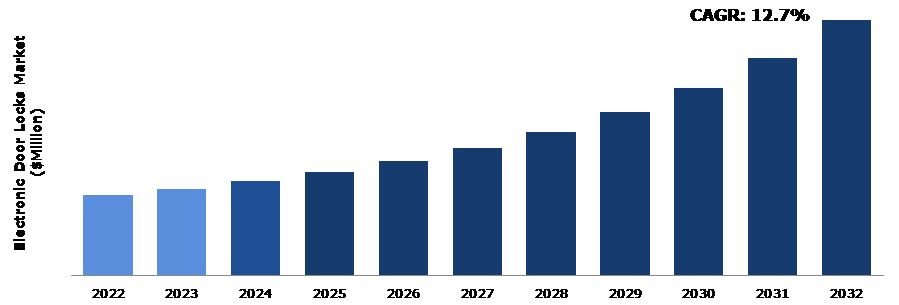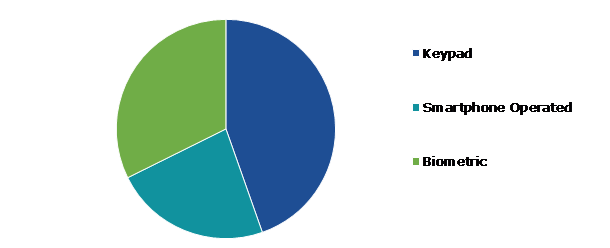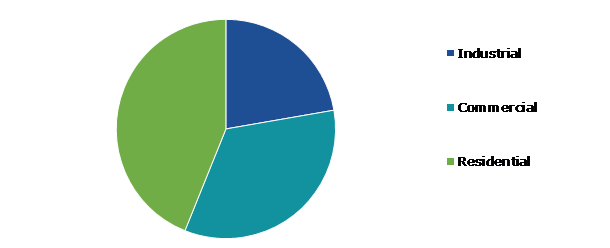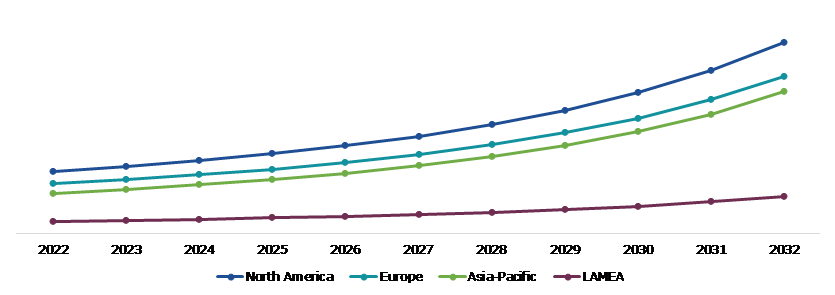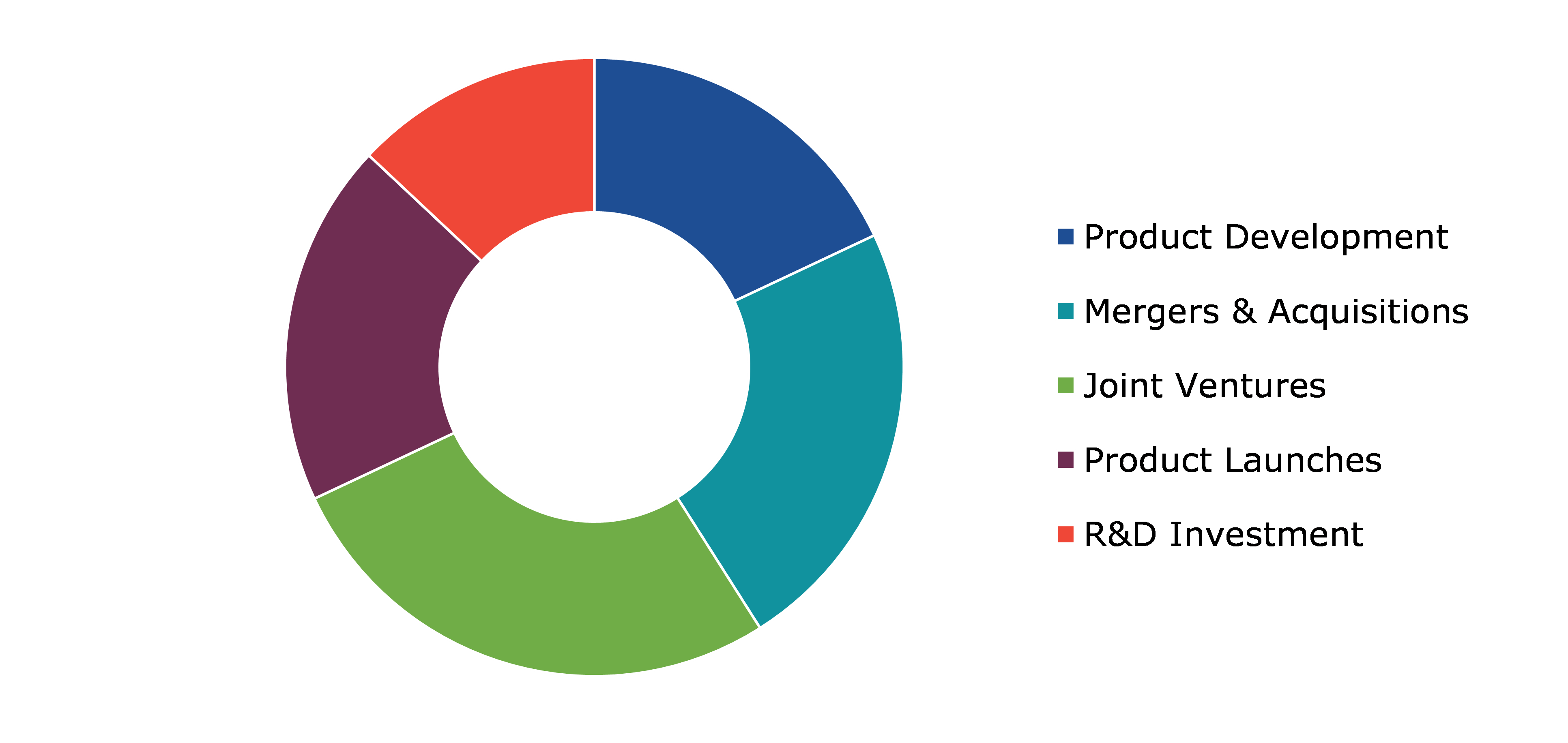Electronic Door Locks Market Report
RA09215
Electronic Door Locks Market by Product Type (Keypad, Smartphone Operated, and Biometric), End User (Industrial, Commercial, and Residential) and Region (North America, Europe, Asia-Pacific, and LAMEA): Opportunity Analysis and Industry Forecast, 2023-2032
Electronic Door Locks Overview
Electronic door locks are security devices that utilize motor-driven actuators controlled by electrical impulses to lock and unlock doors. These locks can be activated by electronic inputs such as card readers, keypads, or wireless remote sensors, eliminating the need for traditional keys. They offer automation features like remote access and monitoring via smartphone applications.
Global Electronic Door Locks Market Analysis
The global electronic door locks market was $5,310.50 million in 2022 and is predicted to grow with a CAGR of 12.7%, generating a revenue of $16,894.70 million by 2032.
Source: Research Dive Analysis
COVID-19 Impact on Global Electronic Door Locks Market
The global Electronic Door Locks market has experienced significant growth due to the impact of the COVID-19 pandemic. As people adapted to remote work, learning, and leisure activities, there was a surge in the adoption of smart devices, including electronic door locks. The pandemic heightened awareness about health and safety, driving the demand for touchless smart locks, video doorbells, and voice-controlled assistants to minimize physical contact and enhance home security. The ability to remotely monitor and manage various aspects of home security became increasingly important during the pandemic. For instance, in the EU7 countries of France, Germany, Belgium, the UK, Italy, the Netherlands, and Spain, there was a notable 24% increase in sales of electronic door locks during the COVID-19 pandemic. This trend is expected to persist in the post-pandemic period as consumers continue to prioritize convenience, comfort, and safety within their homes.
Rising Demand for Smart Homes to Drive the Market Growth
The Electronic Door Locks market has experienced steady growth in recent years, driven by several factors including rapid urbanization, increased adoption in residential complexes and smart homes, rising security concerns, and greater usage in banks, financial institutions, and corporate buildings. With more people migrating to urban areas, the demand for innovative solutions to address urban challenges and improve urban living experiences has surged. Urban environments typically experience higher crime rates, heightening the importance of security for city dwellers. Smart door locks have emerged as a popular solution due to their advanced security features such as remote monitoring, access control, and real-time alerts. These features provide urban residents with greater peace of mind and enhanced protection for their homes and businesses. As urbanization continues and security concerns persist, the Electronic Door Locks market is expected to maintain its upward trajectory, driven by the ongoing need for advanced security solutions in urban settings.
High Cost of Electronic Door Locks Devices to Restrain the Market Growth
The Electronic Door Locks market faces challenges due to the high cost of devices, which can deter many consumers from adopting smart home technology. Price-sensitive customers may struggle to justify the expense of investing in electronic door locks, especially if they perceive them as a luxury rather than a necessity. This higher upfront cost may limit the market to a smaller segment of the population, impeding widespread adoption. The affordability barrier posed by the high cost of electronic door locks can slow down market penetration and adoption rates. Consumers may opt to delay or forgo purchasing these devices due to their price points, leading to a slower rate of market growth. These factors are expected to pose significant challenges to the market's revenue growth during the forecast period.
Advancements in Technology to Drive Excellent Opportunities
Electronic door locks play a crucial role in enhancing data center physical security by safeguarding valuable assets stored in enclosed cabinets or containment areas. These locks, often integrated with RFID card or biometric access control systems, effectively deter unauthorized access attempts. When combined with Data Center Infrastructure Management (DCIM) software, electronic door locks offer centralized door access management, saving time and eliminating the hassle of managing physical keys. This integration also helps organizations meet compliance requirements, such as HIPAA, by providing granular access permissions and detailed audit trails. With features like remote door lock control, card reader management, access permissions, and audit reports, electronic door locks with DCIM software provide comprehensive security solutions for data centers. These major factors are predicted to boost the Electronic Door Locks market expansion in upcoming years.
Global Electronic Door Locks Market Share, by Type, 2022
Source: Research Dive Analysis
The keypad sub-segment accounted for the highest market share in 2022. The primary function of a lock is to keep a facility or property secured. Rather of a key, this sort of lock system requires a numerical code to gain access to a facility or property. Users enter the code using a numerical pad similar to those found on simple calculators. If you enter the proper code, the door lock or deadbolt should disengage. Some systems require batteries or a tiny electrical current to activate. The main advantage is convenience. It eliminates the need for keys. There is no need to carry them around, keep track of duplicates and spares, or change locks if a key is stolen or forgotten. Instead of a key, children, guests, and service providers can be given a unique code or a temporary code. This factor is expected to drive the segment growth during the forecast years.
Global Electronic Door Locks Market Share, by End User, 2022
Source: Research Dive Analysis
The residential sub-segment accounted for the highest market share in 2022. The residential sub-segment has emerged as a dominant force in the electronic door locks market, capturing the highest market share due to the increasing adoption of smart home technology. As homeowners seek to enhance the security and convenience of their residences, electronic door locks offer an attractive solution by providing advanced features such as remote access control and real-time monitoring. The rise in urbanization and the growing trend towards smart homes have further fueled the demand for electronic door locks in residential settings, driving the sub-segment's market dominance. This factor is expected to drive the segment growth during the forecast years.
Global Electronic Door Locks Market Size & Forecast, by Region, 2022-2032 ($Million)
Source: Research Dive Analysis
The North America Electronic Door Locks market generated the highest revenue in 2022. The market for electronic door locks in North America is experiencing significant growth, driven by increasing demand for smart home technology and heightened concerns for home security. The North American region has witnessed a surge in smart home adoption as consumers seek greater convenience and connectivity in their living spaces. Concurrently, there is a growing emphasis on ensuring the safety and security of residential properties, further fueling the demand for electronic door locks. This trend has led to a notable increase in the market share of electronic door locks within the North American region. Moreover, North America is home to numerous electronic door lock manufacturing companies that are heavily investing in research and development to enhance the efficiency and safety of their products. These investments are anticipated to further stimulate the demand for electronic door locks in the North American market, solidifying the region's position as a key growth hub for the industry.
Competitive Scenario in the Global Electronic Door Locks Market
Investment and agreement are common strategies followed by major market players. For instance, in 2022, Godrej Locks, a leading manufacturer of innovative locking solutions with 125 years of history, introduced Spacetek Pro, a 100% 'Made in India' digital lock. Spacetek Pro was the newest hi-tech and aesthetically designed keyless home safety solution packed with advanced features like 360-degree fingerprint recognition and auto-locking, among others. The dynamic lock was an ideal fit for modern homes, ensuring top-notch home safety.
Source: Research Dive Analysis
Some of the leading Electronic Door Locks market players are ASSA Abloy AB, Allegion Plc, Spectrum Brands Holdings, Inc., August Home, Inc., Yale Security, Godrej and Boyce Manufacturing Co. Ltd., Samsung Electronics Co., Ltd., Schlage, United Technologies Corporation, Salto Systems S.L.
| Aspect | Particulars |
| Historical Market Estimations | 2020-2021 |
| Base Year for Market Estimation | 2022 |
| Forecast Timeline for Market Projection | 2023-2032 |
| Geographical Scope | North America, Europe, Asia-Pacific, and LAMEA |
|
Segmentation by Type
|
|
|
Segmentation by End-User
|
|
| Key Companies Profiled |
|
Q1. What is the size of the global Electronic Door Locks market?
A. The size of the global Electronic Door Locks market was over $5,310.50 million in 2022 and is projected to reach $16,894.70 million by 2032.
Q2. Which are the major companies in the Electronic Door Locks market?
A. ASSA Abloy AB, Allegion Plc, Spectrum Brands Holdings, Inc., August Home, Inc. are some of the key players in the global Electronic Door Locks market.
Q3. Which region, among others, possesses greater investment opportunities in the future?
A. Asia-Pacific possesses great investment opportunities for investors in the future.
Q4. What will be the growth rate of the Asia-Pacific Electronic Door Locks market?
A. Asia-Pacific Electronic Door Locks market is anticipated to grow at 13.8% CAGR during the forecast period.
Q5. What are the strategies opted by the leading players in this market?
A. Agreement and investment are the two key strategies opted for by the operating companies in this market.
Q6. Which companies are investing more on R&D practices?
A. Yale Security, Godrej and Boyce Manufacturing Co. Ltd., Samsung Electronics Co., Ltd. are the companies investing more on R&D activities for developing new products and technologies.
1. Research Methodology
1.1. Desk Research
1.2. Real time insights and validation
1.3. Forecast model
1.4. Assumptions and forecast parameters
1.5. Market size estimation
1.5.1. Top-down approach
1.5.2. Bottom-up approach
2. Report Scope
2.1. Market definition
2.2. Report overview
2.3. Market segmentation
3. Executive Summary
4. Market Overview
4.1. Introduction
4.2. Growth impact forces
4.2.1. Drivers
4.2.2. Restraints
4.2.3. Opportunities
4.3. Market value chain analysis
4.3.1. List of raw material suppliers
4.3.2. List of manufacturers
4.3.3. List of distributors
4.4. Innovation & sustainability matrices
4.4.1. Technology matrix
4.4.2. Regulatory matrix
4.5. Porter’s five forces analysis
4.5.1. Bargaining power of suppliers
4.5.2. Bargaining power of consumers
4.5.3. Threat of substitutes
4.5.4. Threat of new entrants
4.5.5. Competitive rivalry intensity
4.6. PESTLE analysis
4.6.1. Political
4.6.2. Economical
4.6.3. Social
4.6.4. Technological
4.6.5. Legal
4.6.6. Environmental
4.7. Impact of COVID-19 on Electronic Door Locks market
4.7.1. Pre-covid market scenario
4.7.2. Post-covid market scenario
5. Electronic Door Locks Market Analysis, by Type
5.1. Overview
5.2. Keypad
5.2.1. Definition, key trends, growth factors, and opportunities
5.2.2. Market size analysis, by region, 2022-2032
5.2.3. Market share analysis, by country, 2022-2032
5.3. Smartphone Operated
5.3.1. Definition, key trends, growth factors, and opportunities
5.3.2. Market size analysis, by region, 2022-2032
5.3.3. Market share analysis, by country, 2022-2032
5.4. Biometric
5.4.1. Definition, key trends, growth factors, and opportunities
5.4.2. Market size analysis, by region, 2022-2032
5.4.3. Market share analysis, by country, 2022-2032
5.5. Research Dive Exclusive Insights
5.5.1. Market attractiveness
5.5.2. Competition heatmap
6. Electronic Door Locks Market Analysis, by End-User
6.1. Overview
6.2. Industrial
6.2.1. Definition, key trends, growth factors, and opportunities
6.2.2. Market size analysis, by region, 2022-2032
6.2.3. Market share analysis, by country, 2022-2032
6.3. Commercial
6.3.1. Definition, key trends, growth factors, and opportunities
6.3.2. Market size analysis, by region, 2022-2032
6.3.3. Market share analysis, by country, 2022-2032
6.4. Residential
6.4.1. Definition, key trends, growth factors, and opportunities
6.4.2. Market size analysis, by region, 2022-2032
6.4.3. Market share analysis, by country, 2022-2032
6.5. Research Dive Exclusive Insights
6.5.1. Market attractiveness
6.5.2. Competition heatmap
7. Electronic Door Locks Market, by Region
7.1. North America
7.1.1. U.S.
7.1.1.1. Market size analysis, by Type, 2022-2032
7.1.1.2. Market size analysis, by End-User, 2022-2032
7.1.2. Canada
7.1.2.1. Market size analysis, by Type, 2022-2032
7.1.2.2. Market size analysis, by End-User, 2022-2032
7.1.3. Mexico
7.1.3.1. Market size analysis, by Type, 2022-2032
7.1.3.2. Market size analysis, by End-User, 2022-2032
7.1.4. Research Dive Exclusive Insights
7.1.4.1. Market attractiveness
7.1.4.2. Competition heatmap
7.2. Europe
7.2.1. Germany
7.2.1.1. Market size analysis, by Type, 2022-2032
7.2.1.2. Market size analysis, by End-User, 2022-2032
7.2.2. UK
7.2.2.1. Market size analysis, by Type, 2022-2032
7.2.2.2. Market size analysis, by End-User, 2022-2032
7.2.3. France
7.2.3.1. Market size analysis, by Type, 2022-2032
7.2.3.2. Market size analysis, by End-User, 2022-2032
7.2.4. Spain
7.2.4.1. Market size analysis, by Type, 2022-2032
7.2.4.2. Market size analysis, by End-User, 2022-2032
7.2.5. Italy
7.2.5.1. Market size analysis, by Type, 2022-2032
7.2.5.2. Market size analysis, by End-User, 2022-2032
7.2.6. Rest of Europe
7.2.6.1. Market size analysis, by Type, 2022-2032
7.2.6.2. Market size analysis, by End-User, 2022-2032
7.2.7. Research Dive Exclusive Insights
7.2.7.1. Market attractiveness
7.2.7.2. Competition heatmap
7.3. Asia-Pacific
7.3.1. China
7.3.1.1. Market size analysis, by Type, 2022-2032
7.3.1.2. Market size analysis, by End-User, 2022-2032
7.3.2. Japan
7.3.2.1. Market size analysis, by Type, 2022-2032
7.3.2.2. Market size analysis, by End-User, 2022-2032
7.3.3. India
7.3.3.1. Market size analysis, by Type, 2022-2032
7.3.3.2. Market size analysis, by End-User, 2022-2032
7.3.4. Australia
7.3.4.1. Market size analysis, by Type, 2022-2032
7.3.4.2. Market size analysis, by End-User, 2022-2032
7.3.5. South Korea
7.3.5.1. Market size analysis, by Type, 2022-2032
7.3.5.2. Market size analysis, by End-User, 2022-2032
7.3.6. Rest of Asia-Pacific
7.3.6.1. Market size analysis, by Type, 2022-2032
7.3.6.2. Market size analysis, by End-User, 2022-2032
7.3.7. Research Dive Exclusive Insights
7.3.7.1. Market attractiveness
7.3.7.2. Competition heatmap
7.4. LAMEA
7.4.1. Brazil
7.4.1.1. Market size analysis, by Type, 2022-2032
7.4.1.2. Market size analysis, by End-User, 2022-2032
7.4.2. Saudi Arabia
7.4.2.1. Market size analysis, by Type, 2022-2032
7.4.2.2. Market size analysis, by End-User, 2022-2032
7.4.3. UAE
7.4.3.1. Market size analysis, by Type, 2022-2032
7.4.3.2. Market size analysis, by End-User, 2022-2032
7.4.4. South Africa
7.4.4.1. Market size analysis, by Type, 2022-2032
7.4.4.2. Market size analysis, by End-User, 2022-2032
7.4.5. Rest of LAMEA
7.4.5.1. Market size analysis, by Type, 2022-2032
7.4.5.2. Market size analysis, by End-User, 2022-2032
7.4.6. Research Dive Exclusive Insights
7.4.6.1. Market attractiveness
7.4.6.2. Competition heatmap
8. Competitive Landscape
8.1. Top winning strategies, 2022
8.1.1. By strategy
8.1.2. By year
8.2. Strategic overview
8.3. Market share analysis, 2022
9. Company Profiles
9.1. ASSA Abloy AB
9.1.1. Overview
9.1.2. Business segments
9.1.3. Product portfolio
9.1.4. Financial performance
9.1.5. Recent developments
9.1.6. SWOT analysis
9.2. Allegion Plc
9.2.1. Overview
9.2.2. Business segments
9.2.3. Product portfolio
9.2.4. Financial performance
9.2.5. Recent developments
9.2.6. SWOT analysis
9.3. Spectrum Brands Holdings, Inc.
9.3.1. Overview
9.3.2. Business segments
9.3.3. Product portfolio
9.3.4. Financial performance
9.3.5. Recent developments
9.3.6. SWOT analysis
9.4. August Home, Inc.
9.4.1. Overview
9.4.2. Business segments
9.4.3. Product portfolio
9.4.4. Financial performance
9.4.5. Recent developments
9.4.6. SWOT analysis
9.5. Yale Security
9.5.1. Overview
9.5.2. Business segments
9.5.3. Product portfolio
9.5.4. Financial performance
9.5.5. Recent developments
9.5.6. SWOT analysis
9.6. Godrej and Boyce Manufacturing Co. Ltd.
9.6.1. Overview
9.6.2. Business segments
9.6.3. Product portfolio
9.6.4. Financial performance
9.6.5. Recent developments
9.6.6. SWOT analysis
9.7. Samsung Electronics Co., Ltd.
9.7.1. Overview
9.7.2. Business segments
9.7.3. Product portfolio
9.7.4. Financial performance
9.7.5. Recent developments
9.7.6. SWOT analysis
9.8. Schlage
9.8.1. Overview
9.8.2. Business segments
9.8.3. Product portfolio
9.8.4. Financial performance
9.8.5. Recent developments
9.8.6. SWOT analysis
9.9. United Technologies Corporation
9.9.1. Overview
9.9.2. Business segments
9.9.3. Product portfolio
9.9.4. Financial performance
9.9.5. Recent developments
9.9.6. SWOT analysis
9.10. Salto Systems S.L.
9.10.1. Overview
9.10.2. Business segments
9.10.3. Product portfolio
9.10.4. Financial performance
9.10.5. Recent developments
9.10.6. SWOT analysis
Personalize this research
- Triangulate with your own data
- Request your format and definition
- Get a deeper dive on a specific application, geography, customer or competitor
- + 1-888-961-4454 Toll - Free
- support@researchdive.com

